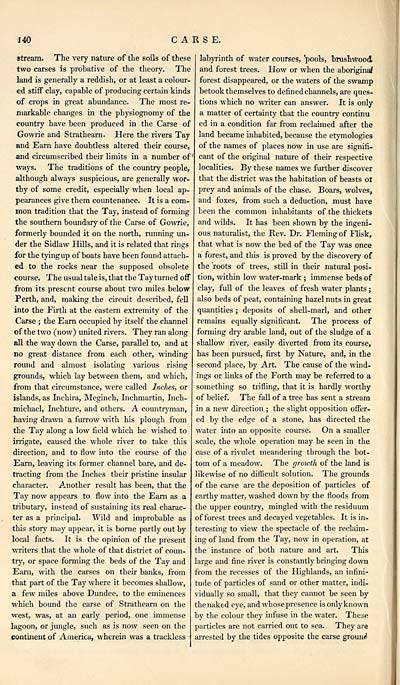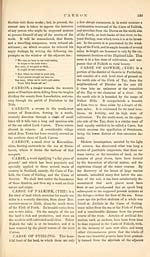Gazetteer of Scotland > Volume 1
(168) Page 140
Download files
Complete book:
Individual page:
Thumbnail gallery: Grid view | List view

140
C A R S E,
stream. The very nature of the soils of these
two carses is probative of the theory. The
land is generally a reddish, or at least a colour-
ed stiff clay, capable of producing certain kinds
of crops in great abundance. The most re-
markable changes in the physiognomy of the
country have been produced in the Carse of
Gowrie and Stratheam. Here the rivers Tay
and Earn have doubtless altered their course,
and circumscribed their limits in a number of
ways. The traditions of the country people,
although always suspicious, are generally wor-
thy of some credit, especially when local ap-
pearances give them countenance. It is a com-
mon tradition that the Tay, instead of forming
the southern boundary of the Carse of Gowrie,
formerly bounded it on the north, running un-
der the Sidlaw Hills, and it is related that rings
for the tyingup of boats have been found attach-
ed to the rocks near the supposed obsolete
course. The usual tale is, that the Tay turned off
from its present course about two miles below
Perth, and, making the circuit described, fell
into the Firth at the eastern extremity of the
Carse ; the Earn occupied by itself the channel
of the two (now) united rivers. They ran along
all the way down the Carse, parallel to, and at
no great distance from each other, winding
round and almost isolating various rising
grounds, which lay between them, and which,
from that circumstance, were called Inches, or
islands, as Inchira, Meginch, Inchmartin, Inch-
michael, Inchture, and others. A countryman,
having drawn a furrow with his plough from
the Tay along a low field which he wished to
irrigate, caused the whole river to take this
direction, and to flow into the course of the
Earn, leaving its former channel bare, and de-
tracting from the Inches their pristine insular
character. Another result has been, that the
Tay now appears to flow into the Earn as a
tributary, instead of sustaining its real charac-
ter as a principal. Wild and improbable as
this story may appear, it is borne partly out by
local facts. It is the opinion of the present
writers that the whole of that district of coun-
try, or space forming the beds of the Tay and
Earn, with the carses on their banks, from
that part of the Tay where it becomes shallow,
a few miles above Dundee, to the eminences
which bound the carse of Stratheam on the
west, was, at an early period, one immense
lagoon, or jungle, such as is now seen on the
continent of America, wherein was a trackless
labyrinth of water courses, pools, brushwood
and forest trees. How or when the aborigina/
forest disappeared, or the waters of the swamp
betook themselves to defined channels, are ques-
tions which no writer can answer. It is only
a matter of certainty that the country continu
ed in a condition far from reclaimed after the
land became inhabited, because the etymologies
of the names of places now in use are signifi-
cant of the original nature of their respective
localities. By these names we further discover
that the district was the habitation of beasts ol
prey and animals of the chase. Boars, wolves,
and foxes, from such a deduction, must have
been the common inhabitants of the thickets
and wilds. It has been shown by the ingeni-
ous naturalist, the Rev. Dr. Fleming of Flisk,
that what is now the bed of the Tay was once
a forest, and this is proved by the discovery of
the roots of trees, still in their natural posi-
tion, within low water-mark ; immense beds of
clay, full of the leaves of fresh water plants ;
also beds of peat, containing hazel nuts in great
quantities ; deposits of shell-marl, and other
remains equally significant. The process of
forming dry arable land, out of the sludge of a
shallow river, easily diverted from its course,
has been pursued, first by Nature, and, in the
second place, by Art. The cause of the wind-
ings or links of the Forth may be referred to a
something so trifling, that it is hardly worthy
of belief. The fall of a tree has sent a stream
in a new direction ; the slight opposition offer-
ed by the edge of a stone, has directed the
water into an opposite course. On a smaller
scale, the whole operation may be seen in the
case of a rivulet meandering through the bot-
tom of a meadow. The growth of the land is
likewise of no difficult solution. The grounds
of the carse are the deposition of particles of
earthy matter, washed down by the floods from
the upper country, mingled with the residuum
of forest trees and decayed vegetables. It is in-
teresting to view the spectacle of the reclaim-
ing of land from the Tay, now in operation, at
the instance of both nature and art. This
large and fine river is constantly bringing down
from the recesses of the Highlands, an infini-
tude of particles of sand or other matter, indi-
vidually so small, that they cannot be seen by
thenaked eye, and whose presence is only known
by the colour they infuse in the water. These
particles are not carried out to sea. They are
arrested by the tides opposite the carse ground
C A R S E,
stream. The very nature of the soils of these
two carses is probative of the theory. The
land is generally a reddish, or at least a colour-
ed stiff clay, capable of producing certain kinds
of crops in great abundance. The most re-
markable changes in the physiognomy of the
country have been produced in the Carse of
Gowrie and Stratheam. Here the rivers Tay
and Earn have doubtless altered their course,
and circumscribed their limits in a number of
ways. The traditions of the country people,
although always suspicious, are generally wor-
thy of some credit, especially when local ap-
pearances give them countenance. It is a com-
mon tradition that the Tay, instead of forming
the southern boundary of the Carse of Gowrie,
formerly bounded it on the north, running un-
der the Sidlaw Hills, and it is related that rings
for the tyingup of boats have been found attach-
ed to the rocks near the supposed obsolete
course. The usual tale is, that the Tay turned off
from its present course about two miles below
Perth, and, making the circuit described, fell
into the Firth at the eastern extremity of the
Carse ; the Earn occupied by itself the channel
of the two (now) united rivers. They ran along
all the way down the Carse, parallel to, and at
no great distance from each other, winding
round and almost isolating various rising
grounds, which lay between them, and which,
from that circumstance, were called Inches, or
islands, as Inchira, Meginch, Inchmartin, Inch-
michael, Inchture, and others. A countryman,
having drawn a furrow with his plough from
the Tay along a low field which he wished to
irrigate, caused the whole river to take this
direction, and to flow into the course of the
Earn, leaving its former channel bare, and de-
tracting from the Inches their pristine insular
character. Another result has been, that the
Tay now appears to flow into the Earn as a
tributary, instead of sustaining its real charac-
ter as a principal. Wild and improbable as
this story may appear, it is borne partly out by
local facts. It is the opinion of the present
writers that the whole of that district of coun-
try, or space forming the beds of the Tay and
Earn, with the carses on their banks, from
that part of the Tay where it becomes shallow,
a few miles above Dundee, to the eminences
which bound the carse of Stratheam on the
west, was, at an early period, one immense
lagoon, or jungle, such as is now seen on the
continent of America, wherein was a trackless
labyrinth of water courses, pools, brushwood
and forest trees. How or when the aborigina/
forest disappeared, or the waters of the swamp
betook themselves to defined channels, are ques-
tions which no writer can answer. It is only
a matter of certainty that the country continu
ed in a condition far from reclaimed after the
land became inhabited, because the etymologies
of the names of places now in use are signifi-
cant of the original nature of their respective
localities. By these names we further discover
that the district was the habitation of beasts ol
prey and animals of the chase. Boars, wolves,
and foxes, from such a deduction, must have
been the common inhabitants of the thickets
and wilds. It has been shown by the ingeni-
ous naturalist, the Rev. Dr. Fleming of Flisk,
that what is now the bed of the Tay was once
a forest, and this is proved by the discovery of
the roots of trees, still in their natural posi-
tion, within low water-mark ; immense beds of
clay, full of the leaves of fresh water plants ;
also beds of peat, containing hazel nuts in great
quantities ; deposits of shell-marl, and other
remains equally significant. The process of
forming dry arable land, out of the sludge of a
shallow river, easily diverted from its course,
has been pursued, first by Nature, and, in the
second place, by Art. The cause of the wind-
ings or links of the Forth may be referred to a
something so trifling, that it is hardly worthy
of belief. The fall of a tree has sent a stream
in a new direction ; the slight opposition offer-
ed by the edge of a stone, has directed the
water into an opposite course. On a smaller
scale, the whole operation may be seen in the
case of a rivulet meandering through the bot-
tom of a meadow. The growth of the land is
likewise of no difficult solution. The grounds
of the carse are the deposition of particles of
earthy matter, washed down by the floods from
the upper country, mingled with the residuum
of forest trees and decayed vegetables. It is in-
teresting to view the spectacle of the reclaim-
ing of land from the Tay, now in operation, at
the instance of both nature and art. This
large and fine river is constantly bringing down
from the recesses of the Highlands, an infini-
tude of particles of sand or other matter, indi-
vidually so small, that they cannot be seen by
thenaked eye, and whose presence is only known
by the colour they infuse in the water. These
particles are not carried out to sea. They are
arrested by the tides opposite the carse ground
Set display mode to: Large image | Transcription
Images and transcriptions on this page, including medium image downloads, may be used under the Creative Commons Attribution 4.0 International Licence unless otherwise stated. ![]()
| Gazetteers of Scotland, 1803-1901 > Gazetteer of Scotland > Volume 1 > (168) Page 140 |
|---|
| Permanent URL | https://digital.nls.uk/97426378 |
|---|
| Description | Volume I: Abbey to Glenartney. |
|---|---|
| Attribution and copyright: |
|
| Description | By Robert Chambers and William Chambers. Glasgow: Blackie & Son, 1838. 2 volumes. |
|---|---|
| Shelfmark | NF.1461.g.7 |
| Additional NLS resources: | |

